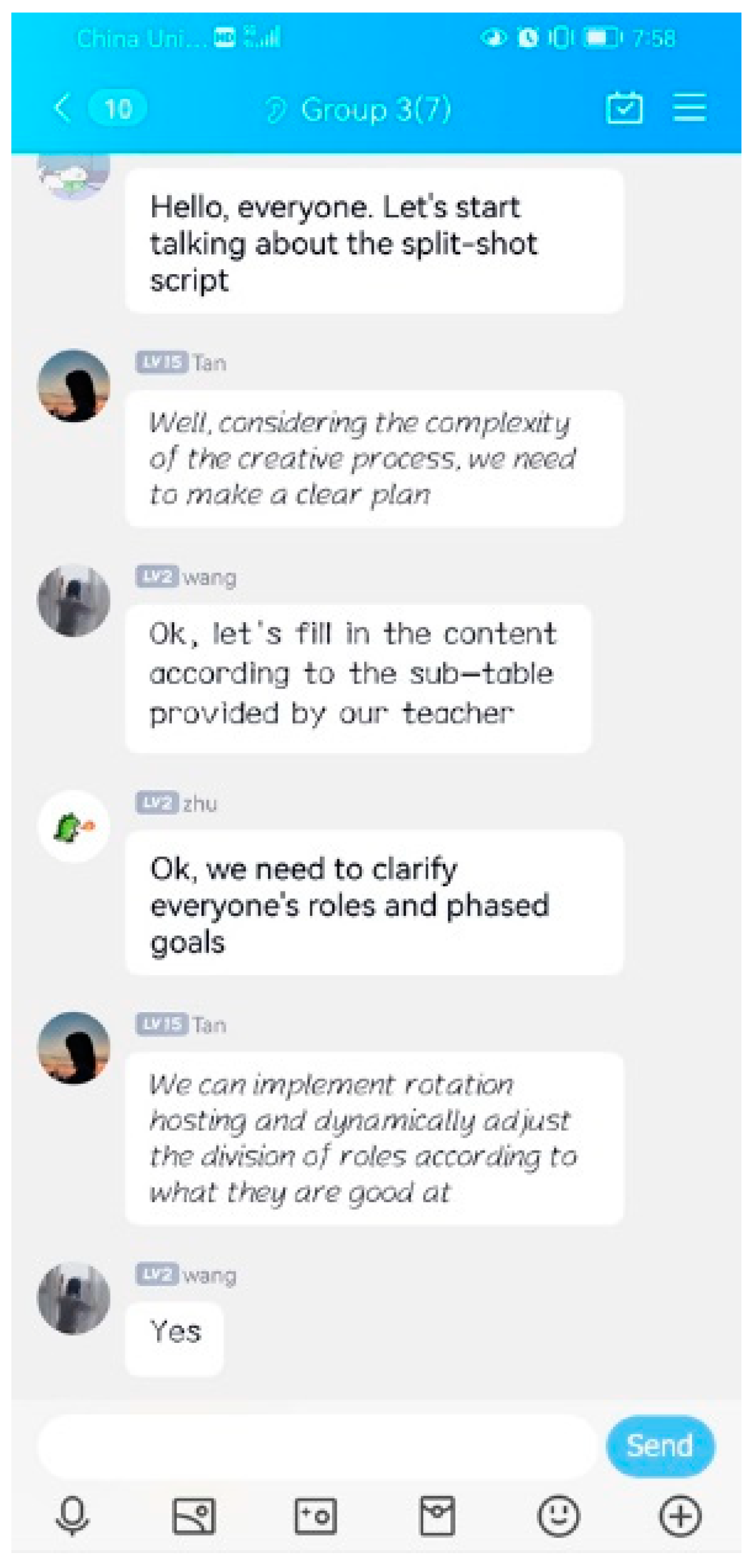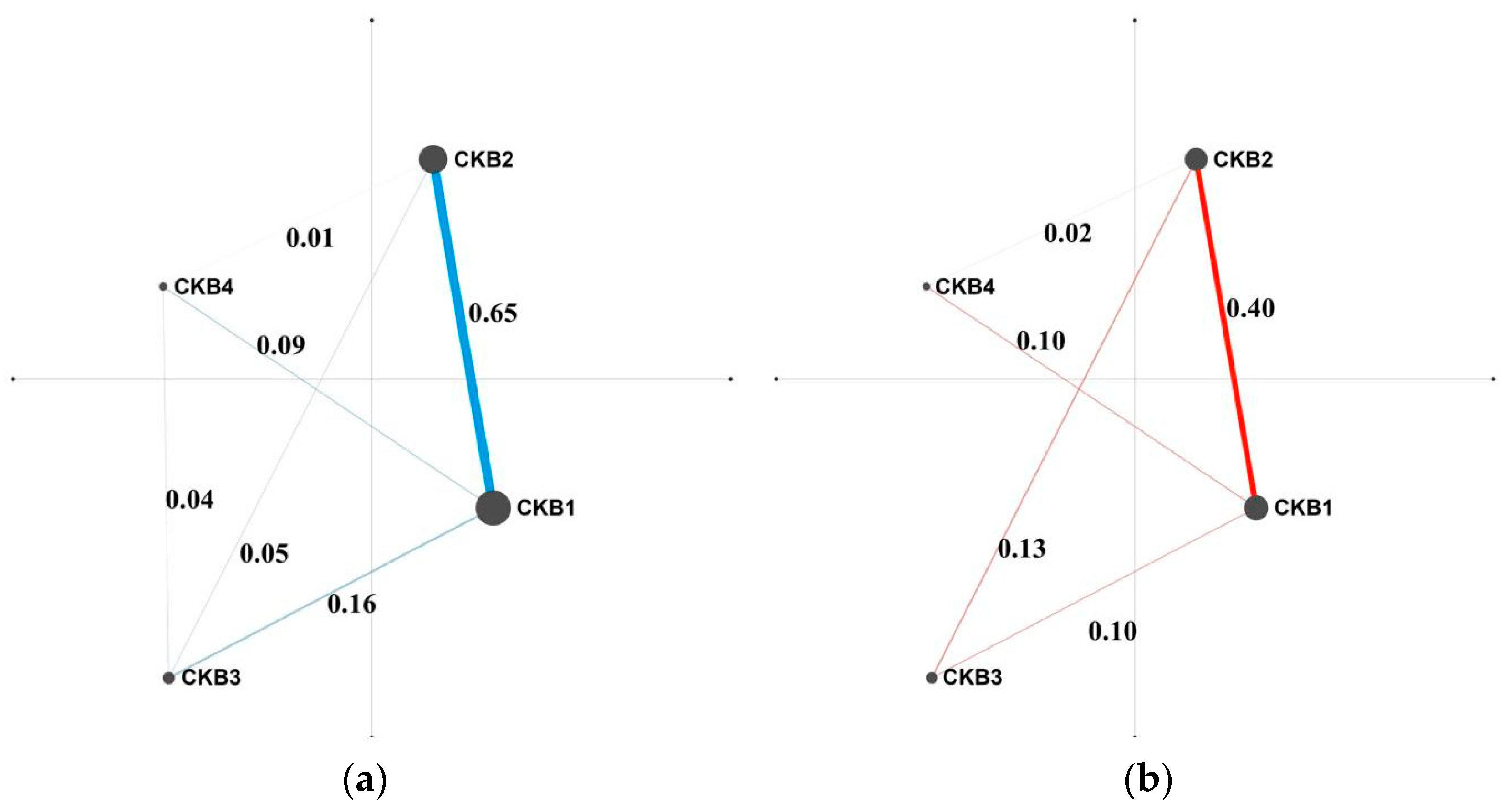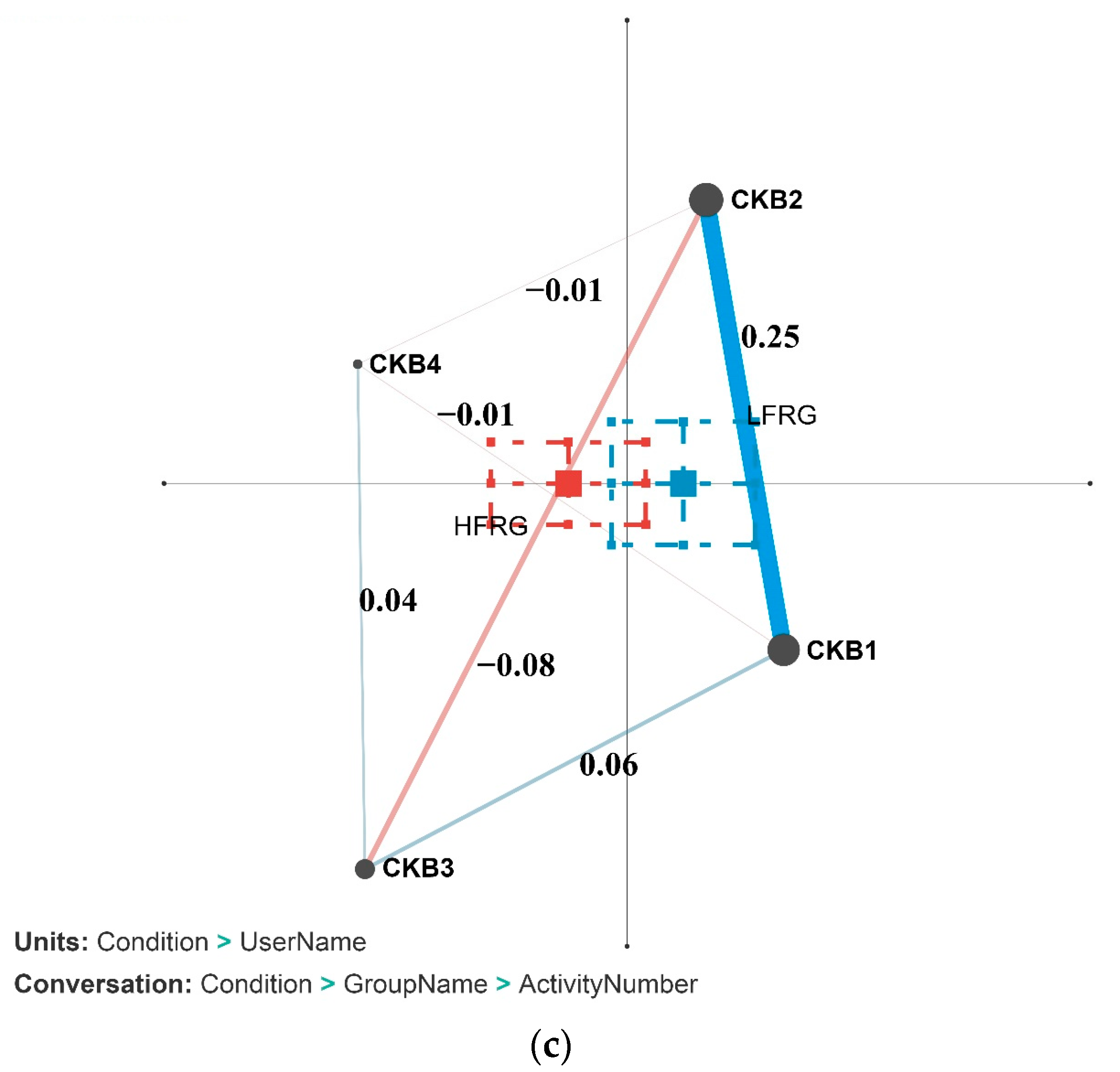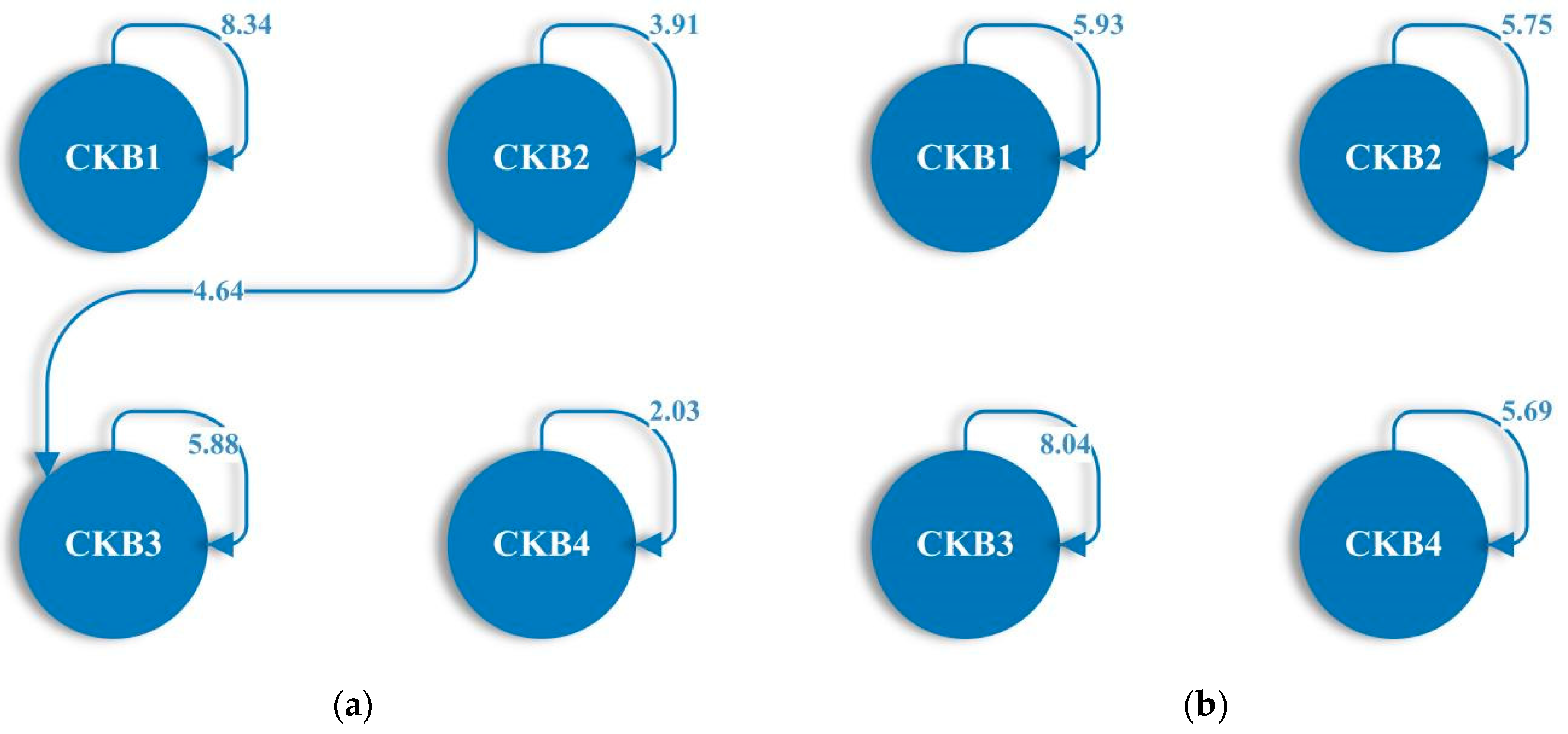Research on the Influence of Socially Regulated Learning on Online Collaborative Knowledge Building in the Post COVID-19 Period
Abstract
:1. Introduction
- (1).
- What are the characteristics of regulation focus under the influence of intervention scripts?
- (2).
- What are the levels and behavioral characteristics of CKB under the influence of intervention scripts?
- (3).
- What is the influence mechanism of SoRL on CKB?
2. Materials and Methods
2.1. Participants
2.2. Instruments
2.3. Research Design
2.4. Learning Tasks and Collaborative Learning Design
2.4.1. Shared Metacognitive Knowledge Prompt Script
2.4.2. Shared Metacognitive Control Prompt Script
2.5. Coding Scheme
2.6. Data Collection and Analysis
3. Results
3.1. Features of SoRL Regulation Focus
3.2. Analysis of CKB Level Differences
3.3. CKB Behavior Sequence Analysis
4. Discussion
4.1. Analysis of the Activation of SoRL Intervention on Regulation Focus
4.2. ENA of CKB
4.3. Lag Sequence Analysis of CKB
4.4. The Mechanism of SoRL Promoting CKB
5. Conclusions
Supplementary Materials
Author Contributions
Funding
Institutional Review Board Statement
Informed Consent Statement
Data Availability Statement
Acknowledgments
Conflicts of Interest
References
- Fedoruk, L.; Wright, A.; Anowai, A.; Osondu, Y. Students as partners in a COVID-19 online teaching and learning environment. Int. J. Innov. Online Educ. 2021, 5, 59–76. [Google Scholar] [CrossRef]
- Muktiarni, M.; Ana, A.; Dwiyanti, V.; Sari, A.R.; Mupita, J. Digital platform trends in vocational education during the COVID-19 pandemic. J. Tech. Educ. Train. 2021, 13, 180–189. [Google Scholar] [CrossRef]
- Liang, W.; Liu, M.; Liu, J.; Wang, Y.; Wu, J.; Liu, X. The dynamic COVID-zero strategy on prevention and control of COVID-19 in China. Natl. Med. J. China 2022, 102, 239–242. [Google Scholar] [CrossRef]
- Chang, T.Y.; Hsu, M.L.; Kwon, J.S.; Kusdhany, M.F.L.; Hong, G. Effect of online learning for dental education in Asia during the pandemic of COVID-19. J. Dent. Sci. 2021, 16, 1095–1101. [Google Scholar] [CrossRef]
- Thamri, T.; Hasan, D.; Rina, N.; Gani, M.; Miranda, A. Advantages and disadvantages of online Learning during the COVID-19 pandemic: The perceptions of students at Bung Hatta University. In Proceedings of the KnE Social Sciences/The Second Economics, Law, Education and Humanities International Conference (ELEHIC-2021), Padang, Indonesia, 14–15 October 2021; pp. 329–338. [Google Scholar] [CrossRef]
- Ngo, V.T. Effectiveness of online learning when implementing collaborative online learning in flipped classroom. Tech. Soc. Sci. J. 2021, 26, 234–249. [Google Scholar] [CrossRef]
- Lawrence, K.C.; Fakuade, O.V. Parental involvement, learning participation and online learning commitment of adolescent learners during the COVID-19 lockdown. Res. Learn. Technol. 2021, 29, 2544. [Google Scholar] [CrossRef]
- Hsu, M.J.; Hsieh, M.C.; Opoku, E. Knowledge co-creation during the COVID-19 pandemic: A dual-regulated learning model in virtual hospitality communities. Sustainability 2022, 14, 4664. [Google Scholar] [CrossRef]
- Ng, P.M.L.; Chan, J.K.Y.; Lit, K.K. Student learning performance in online collaborative learning. Educ. Inf. Technol. 2022, 27, 8129–8145. [Google Scholar] [CrossRef]
- Sobocinski, M.; Malmberg, J.; Järvelä, S. Exploring adaptation in socially-shared regulation of learning using video and heart rate data. Technol. Knowl. Learn. 2022, 27, 385–404. [Google Scholar] [CrossRef]
- Hadwin, A.F.; Oshige, M. Self-regulation, coregulation, and socially shared regulation: Exploring perspectives of social in self-regulated learning theory. Teach. Coll. Rec. 2011, 113, 240–264. [Google Scholar] [CrossRef]
- Panadero, E.; Järvelä, S. Socially shared regulation of learning: A review. Eur. Psychol. 2015, 20, 190–203. [Google Scholar] [CrossRef]
- Haataja, E.; Dindar, M.; Malmberg, J.; Järvelä, S. Individuals in a group: Metacognitive and regulatory predictors of learning achievement in collaborative learning. Learn. Individ. Differ. 2022, 96, 102146. [Google Scholar] [CrossRef]
- Li, Y.; Chen, K.; Su, Y.; Yue, X. Do social regulation strategies predict learning engagement and learning outcomes? A study of English language learners in wiki-supported literature circles activities. Educ. Technol. Res. Dev. 2021, 69, 917–943. [Google Scholar] [CrossRef]
- De Backer, L.; Keer, H.; Valcke, M. Socially shared metacognitive regulation during reciprocal peer tutoring: Identifying its relationship with students’ content processing and transactive discussions. Instr. Sci. 2015, 43, 323–344. [Google Scholar] [CrossRef]
- Raes, A.; Schellens, T.; De Wever, B.; Benoit, D. Promoting metacognitive regulation through collaborative problem solving on the web: When scripting does not work. Comput. Hum. Behav. 2016, 58, 325–342. [Google Scholar] [CrossRef]
- Molenaar, I.; Roda, C.; van Boxtel, C.; Sleegers, P. Dynamic scaffolding of socially regulated learning in a computer-based learning environment. Comput. Educ. 2012, 59, 515–523. [Google Scholar] [CrossRef]
- Zheng, L.; Li, X.; Chen, F. Effects of a mobile self-regulated learning approach on students’ learning achievements and self-regulated learning skills. Innov. Educ. Teach. Int. 2016, 55, 616–624. [Google Scholar] [CrossRef]
- Scardamalia, M.; Bereiter, C.; Sawyer, K. (Eds.) Cambridge Handbook of the Learning Sciences. Knowledge Building: Theory, Pedagogy, and Technology; Cambridge University Press: New York, NY, USA, 2014; pp. 397–417. [Google Scholar] [CrossRef]
- Lawrence, R. A small circle of friends: Cohort groups as learning communities. New Dir. Adult Contin. Educ. 2002, 95, 83–92. [Google Scholar] [CrossRef]
- Tan, S.C.; Chan, C.; Bielaczyc, K.; Ma, L.; Scardamalia, M.; Bereiter, C. Knowledge building: Aligning education with needs for knowledge creation in the digital age. Educ. Technol. Res. Dev. 2021, 69, 2243–2266. [Google Scholar] [CrossRef]
- McDonald, C. Information systems Foundations-Karl Popper’s third world. Australas. J. Inform. Syst. 2002, 10, 59–69. [Google Scholar] [CrossRef] [Green Version]
- Lossman, H.; So, H.J. Toward pervasive knowledge building discourse: Analyzing online and offline discourses of primary science learning in Singapore. Asia Pacific Educ. Rev. 2010, 11, 121–129. [Google Scholar] [CrossRef]
- Soliman, D.; Costa, S.; Scardamalia, M. Knowledge building in online mode: Insights and Reflections. Educ. Sci. 2021, 11, 425. [Google Scholar] [CrossRef]
- Scardamalia, M.; Bereiter, C. A brief history of knowledge building. Can. J. Learn. Technol. 2010, 36, 1–16. [Google Scholar] [CrossRef]
- Zhang, J.; Scardamalia, M.; Reeve, R.; Messina, R. Designs for collective cognitive responsibility in knowledge-building communities. J. Learn. Sci. 2009, 18, 7–44. [Google Scholar] [CrossRef]
- Hewitt, J.; Scardamalia, M. Design principles for distributed knowledge building processes. Educ. Psychol. Rev. 1998, 10, 75–96. [Google Scholar] [CrossRef]
- Chai, S.; Zhu, G. The relationship between group adoption of Knowledge Building Principles and performance in creating artifacts. Educ. Technol. Res. Dev. 2021, 69, 787–808. [Google Scholar] [CrossRef]
- Ferreira, D.; Santos, G. Scaffolding online discourse in collaborative Ill-structured problem-solving for innovation. Inform. Educ. 2009, 8, 173–190. [Google Scholar] [CrossRef]
- Zheng, L.; Zhen, Y.; Niu, J.; Zhong, L. An exploratory study on fade-in versus fade-out scaffolding for novice programmers in online collaborative programming settings. J. Comput. Higher Educ. 2022, 34, 489–516. [Google Scholar] [CrossRef]
- Lin, C.Y.; Reigeluth, C. Scaffolding wiki-supported collaborative learning for small-group projects and whole-class collaborative knowledge building. J. Comput. Assist. Learn. 2016, 32, 529–547. [Google Scholar] [CrossRef]
- Vogel, F.; Kollar, I.; Fischer, F.; Reiss, K.; Ufer, S. Adaptable scaffolding of mathematical argumentation skills: The role of self-regulation when scaffolded with CSCL scripts and heuristic worked examples. Int. J. Comput.-Supp. Coll. Learn. 2022, 17, 39–64. [Google Scholar] [CrossRef]
- Weinberger, A.; Clark, D.; Häkkinen, P.; Tamura, Y.; Fischer, F. Argumentative knowledge construction in online learning environments in and across different cultures: A collaboration script perspective. Res. Comp. Int. Educ. 2007, 2, 68–79. [Google Scholar] [CrossRef]
- Ma, L.; Matsuzawa, Y.; Scardamalia, M. Rotating leadership and collective responsibility in a grade 4 knowledge building classroom. Int. J. Organ. Des. Eng. 2016, 4, 54–84. [Google Scholar] [CrossRef]
- Gilbert, N.; Driscoll, M. Collaborative knowledge building: A case study. Educ. Technol. Res. Dev. 2002, 50, 59–79. [Google Scholar] [CrossRef]
- Faul, F.; Erdfelder, E.; Lang, A.G.; Buchner, A. G*Power 3: A flexible statistical power analysis program for the social, behavioral, and biomedical sciences. Behav. Res. Methods 2007, 39, 175–191. [Google Scholar] [CrossRef] [PubMed]
- Olakanmi, E. Development of a questionnaire to measure co-regulated learning strategies during collaborative science learning. J. Balt. Sci. Educ. 2016, 15, 68–78. [Google Scholar] [CrossRef]
- Fischer, F.; Kollar, I.; Stegmann, K.; Wecker, C. Toward a script theory of guidance in computer-supported collaborative learning. Educ. Psychol. 2013, 48, 56–66. [Google Scholar] [CrossRef] [Green Version]
- Chen, C.H.; Law, V. Scaffolding individual and collaborative game-based learning in learning performance and intrinsic motivation. Comput. Hum. Behav. 2015, 55, 1201–1212. [Google Scholar] [CrossRef]
- De Backer, L.; Keer, H.; Valcke, M. Collaborative learning groups’ adoption of shared metacognitive regulation: Examining the impact of structuring versus reflection-provoking support and its relation with group performance. Eur. J. Psychol. Educ. 2020, 36, 1075–1094. [Google Scholar] [CrossRef]
- De Backer, L.; Van Keer, H.; Valcke, M. Exploring evolutions in reciprocal peer tutoring groups’ socially shared metacognitive regulation and identifying its metacognitive correlates. Learn. Instr. 2015, 38, 63–78. [Google Scholar] [CrossRef]
- Su, Y.; Li, Y.; Hu, H.; Rose, C.P. Exploring college English language learners’ self and social regulation of learning during wiki-supported collaborative reading activities. Int. J. Comput. Supp. Coll. Learn. 2018, 13, 35–60. [Google Scholar] [CrossRef]
- Scardamalia, M.; Bereiter, C. Knowledge building: Advancing the state of community knowledge. In International Handbook of Computer-Supported Collaborative Learning; Springer: New York, NY, USA, 2021; pp. 261–279. [Google Scholar] [CrossRef]
- Hod, Y.; Katz, S.; Eagan, B. Refining qualitative ethnographies using Epistemic Network Analysis: A study of socioemotional learning dimensions in a Humanistic Knowledge Building Community. Comput. Educ. 2020, 156, 103943. [Google Scholar] [CrossRef]
- Swiecki, Z.; Ruis, A.; Farrell, C.; Shaffer, D. Assessing individual contributions to collaborative problem solving: A network analysis approach. Comput. Hum. Behav. 2019, 104, 105876. [Google Scholar] [CrossRef]
- Pohl, M.; Wallner, G.; Kriglstein, S. Using lag-sequential analysis for understanding interaction sequences in visualizations. Int. J. Human-Comput. Stud. 2016, 96, 54–66. [Google Scholar] [CrossRef]
- Jafarigohar, M.; Mortazavi, M. The impact of scaffolding mechanisms on EFL learners’ individual and socially shared metacognition in writing. Read. Writ. Quart. 2016, 33, 211–225. [Google Scholar] [CrossRef]
- Janson, A.; Söllner, M.; Leimeister, J.M. Ladders for learning: Is scaffolding the key to teaching problem-solving in technology-mediated learning contexts? Acad. Manag. Learn. Educ. 2020, 19, 439–468. [Google Scholar] [CrossRef] [Green Version]
- Venkatesh, V.; Morris, M.; Davis, G.; Davis, F. User acceptance of information technology: Toward a Unified View. MIS Quart. 2003, 27, 425–478. [Google Scholar] [CrossRef] [Green Version]
- Malmberg, J.; Järvelä, S.; Kirschner, P. Elementary school students’ strategic learning: Does task-type matter? Metacogn. Learn. 2014, 9, 113–136. [Google Scholar] [CrossRef]
- Volet, S.; Summers, M.; Thurman, J. High-level co-regulation in collaborative learning: How does it emerge and how is it sustained? Learn. Instr. 2009, 19, 128–143. [Google Scholar] [CrossRef]
- Hong, H.Y.; Chen, B.; Chai, C. Exploring the development of college students’ epistemic views during their knowledge building activities. Comput. Educ. 2016, 98, 1–13. [Google Scholar] [CrossRef]
- Moreno, R.; Mayer, R. Interactive multimodal learning environments. Educ. Psychol. Rev. 2007, 19, 309–326. [Google Scholar] [CrossRef]
- Trentepohl, S.; Waldeyer, J.; Fleischer, J.; Roelle, J.; Leutner, D.; Wirth, J. How did it get so late so soon? The effects of time management knowledge and practice on students’ time management skills and academic performance. Sustainability 2022, 14, 5097. [Google Scholar] [CrossRef]
- Wolters, C.; Brady, A. College students’ time management: A self-regulated learning perspective. Educ. Psychol. Rev. 2021, 33, 1319–1351. [Google Scholar] [CrossRef]
- Zhang, S.; Chen, J.; Wen, Y.; Chen, H.; Wang, Q. Capturing regulatory patterns in online collaborative learning: A network analytic approach. Int. J. Comput.-Supp. Coll. Learn. 2021, 16, 37–66. [Google Scholar] [CrossRef]
- Näykki, P.; Isohätälä, J.; Järvelä, S.; Pöysä-Tarhonen, J.; Häkkinen, P. Facilitating socio-cognitive and socio-emotional monitoring in collaborative learning with a regulation macro script—An exploratory study. Int. J. Comput.-Supp. Coll. Learn. 2017, 12, 251–279. [Google Scholar] [CrossRef] [Green Version]
- Clayton, R.; Kermarrec, G. Peer assessment and video feedback for fostering self, co, and shared regulation of learning in a higher education language classroom. Front. Educ. 2022, 7, 732094. [Google Scholar] [CrossRef]
- Dautbašić, A.; Saračević, J. The relationship between COVID-19, online learning and intercultural education. J. Educ. Humanit. 2020, 3, 53–66. [Google Scholar] [CrossRef]





| Regulation Focus | Group | Frequency | M (n = 5) | SD | p |
|---|---|---|---|---|---|
| Task understanding | Experimental group | 100 | 20 | 15.00 | 0.275 |
| Control group | 70 | 14 | 15.17 | ||
| Time management | Experimental group | 140 | 28 | 12.55 | 0.011 * |
| Control group | 20 | 4 | 4.18 | ||
| Content monitoring | Experimental group | 515 | 103 | 112.28 | 0.009 * |
| Control group | 60 | 12 | 6.71 | ||
| Positive emotion | Experimental group | 145 | 29 | 17.10 | 0.114 |
| Control group | 55 | 11 | 4.18 | ||
| Negative emotion | Experimental group | 55 | 11 | 11.40 | 0.126 |
| Control group | 5 | 1 | 2.24 | ||
| Organizing | Experimental group | 85 | 17 | 21.10 | 0.054 |
| Control group | 0 | 0 | 0.00 | ||
| Atmosphere activation | Experimental group | 820 | 164 | 117.55 | 0.009 * |
| Control group | 145 | 29 | 8.94 |
| Level | X | Y | ||||
|---|---|---|---|---|---|---|
| U | p | r | U | p | r | |
| CKB1–CKB2 | 148.50 | 0.01 * | 0.46 | 237.50 | 0.41 | 0.14 |
| CKB1–CKB3 | 180.00 | 0.03 * | 0.35 | 275.00 | 0.99 | 0.00 |
| CKB1–CKB4 | 194.50 | 0.07 | 0.30 | 310.50 | 0.44 | −0.12 |
| CKB2–CKB3 | 221.00 | 0.17 | 0.20 | 277.00 | 0.99 | 0.00 |
| CKB2–CKB4 | 233.00 | 0.20 | 0.16 | 299.00 | 0.50 | −0.08 |
| CKB3–CKB4 | 252.50 | 0.31 | 0.09 | 275.50 | 1.00 | 0.00 |
| Level | Experimental Group | Control Group | ||||||
|---|---|---|---|---|---|---|---|---|
| CKB1 | CKB2 | CKB3 | CKB4 | CKB1 | CKB2 | CKB3 | CKB4 | |
| CKB1 | 8.34 | −1.93 | −4.81 | −0.24 | 5.93 | −2.94 | −4.52 | −2.49 |
| CKB2 | −3.14 | 3.91 | 4.64 | 1.66 | −4.22 | 5.75 | 1.79 | −1.13 |
| CKB3 | −2.46 | 0.76 | 5.88 | −0.61 | −2.9 | −1.2 | 8.04 | 1.24 |
| CKB4 | −0.51 | 0.53 | 1.3 | 2.03 | −1.07 | −1.06 | −0.55 | 5.69 |
Publisher’s Note: MDPI stays neutral with regard to jurisdictional claims in published maps and institutional affiliations. |
© 2022 by the authors. Licensee MDPI, Basel, Switzerland. This article is an open access article distributed under the terms and conditions of the Creative Commons Attribution (CC BY) license (https://creativecommons.org/licenses/by/4.0/).
Share and Cite
Lu, J.; Chen, X.; Wang, X.; Zhong, R.; Wang, H. Research on the Influence of Socially Regulated Learning on Online Collaborative Knowledge Building in the Post COVID-19 Period. Sustainability 2022, 14, 15345. https://doi.org/10.3390/su142215345
Lu J, Chen X, Wang X, Zhong R, Wang H. Research on the Influence of Socially Regulated Learning on Online Collaborative Knowledge Building in the Post COVID-19 Period. Sustainability. 2022; 14(22):15345. https://doi.org/10.3390/su142215345
Chicago/Turabian StyleLu, Jia, Xiaohui Chen, Xiaodan Wang, Rong Zhong, and Hanxi Wang. 2022. "Research on the Influence of Socially Regulated Learning on Online Collaborative Knowledge Building in the Post COVID-19 Period" Sustainability 14, no. 22: 15345. https://doi.org/10.3390/su142215345






